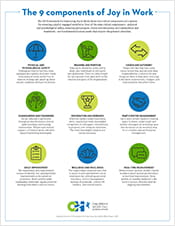Health care worker burnout has hit record highs—and children’s hospitals are not immune to it. “There’s this fundamental disconnect between what called people in the healing profession to their work and the environment they find themselves working in today,” says Jessica Perlo, M.P.H., senior director and improvement advisor at the Institute for Healthcare Improvement (IHI). “We’re seeing this with high staff turnover, absenteeism, burnout, poor mental health, and in some cases, suicide. It’s not new, but it has been exacerbated by the pandemic.”
To help hospitals and health systems engage the strained health care workforce, IHI designed and tested the IHI Framework for Improving Joy in Work. Informed by experts and organizations both in and outside of health care, the Joy in Work Framework outlines nine critical components of a system for ensuring a joyful, engaged workforce and the steps leaders and teams can take to get there.
According to IHI, four of the nine critical components for improving joy in work—physical and psychological safety, meaning and purpose, choice and autonomy, and camaraderie and teamwork—are fundamental human needs that require the greatest attention. Fairness and equity are essential to achieving success among all the components.
Here are the nine components of a joyful, engaged workforce.
Physical and psychological safety
Physical safety refers to the freedom from harm at work. Healthcare workers, particularly nurses, are exposed to high risks of injury, pathogens, and violence in the workplace. Employees must feel adequate precautions have been taken to protect them.
Psychological safety is also essential, referring to an environment in which individuals feel secure and capable of change, free to focus on collective goals and problem prevention without fear of punishment or retribution. This type of safety is founded on respectful interactions and a climate in which people feel free to express relevant thoughts and feelings or speak up about unsafe conditions without fear of negative consequences.
Meaning and purpose
People need to find meaning in their work, feeling connected to a purpose larger than themselves. Daily work should connect to what called individuals to the health care profession, and they should be able to clearly see that connection. Leaders can reinforce that connection by frequently talking about the purpose of collective work and encouraging conversations about the individual and collective purpose in the organization.
Choice and autonomy
People need to feel like they have some choice in how they execute their daily responsibilities, a voice in the way things are done in daily work, and a say in decisions on processes, changes, and improvements that affect them. Two types of structures—participative management and shared governance—emphasize the autonomy and contribution of team members. This can look like employee access to resources without leadership approval, or empowering employees to make process improvements to reduce roadblocks in their work. However, although freedom and trust are essential, employees should also have a clear understanding of rules and guidelines.
Recognition and rewards
Effective leaders understand daily work, regularly provide meaningful recognition of colleagues’ contributions to purpose, and celebrate outcomes. The most meaningful rewards are rarely monetary. Successful initiatives don’t rely on only traditional approaches, such as social gatherings and parties—those must be connected to the comradery and accomplishment of the team.
Participative management
Joy in work entails leaders creating space to listen, understand, and involve colleagues in providing input into decisions as an essential step in co-creation and participative management. Decision making involves clear communication and consensus building. Participative leaders involve others in the beginning stages of an initiative, keep individuals informed of future changes that may impact them, and listen to individuals at all levels in the organization.
Camaraderie and teamwork
Social cohesion is generated through productive teams, shared understanding, and trusting relationships. People have mutual support, feel they are part of a team, and work toward something meaningful together. Importantly, they have a friend at work who cares about them and who they get advice from. Mutual trust isn’t just between employees but also with leadership.
Daily improvement
The organization uses improvement science to identify, test, and implement improvements to the system or processes. Teams and the wider organization undertake regular proactive learning from defects and successes.
Wellness and resilience
The organization demonstrates that it values health and wellness of all employees by cultivating personal resilience, stress management, feelings of gratitude, a work-life balance, and mental health.
Real-time measurement
Measurement systems enable regular feedback about system performance to facilitate improvement. Daily, weekly, or monthly feedback is the norm to ensure effective data for ongoing improvement.
For the full descriptions of the nine components and the Joy in Work Framework, view IHI’s white paper.



